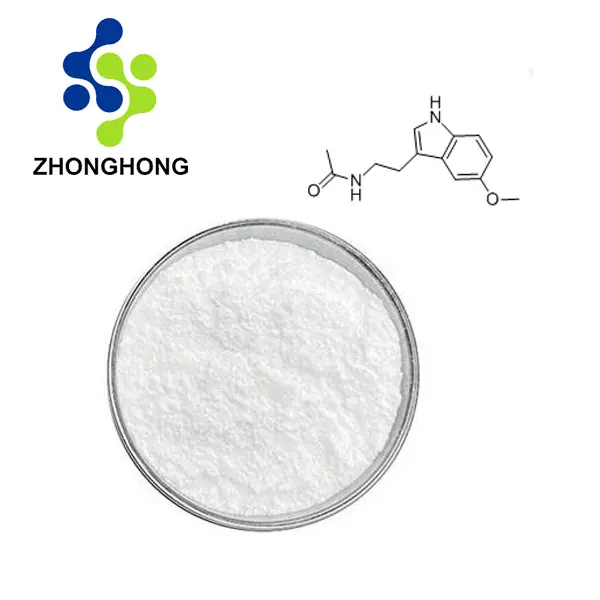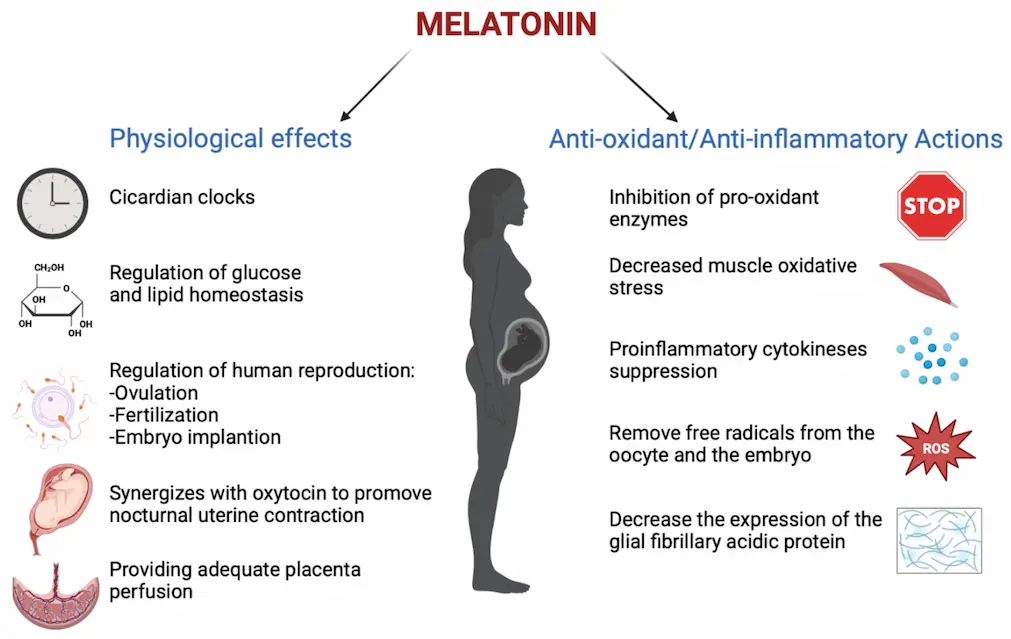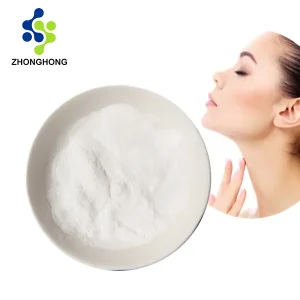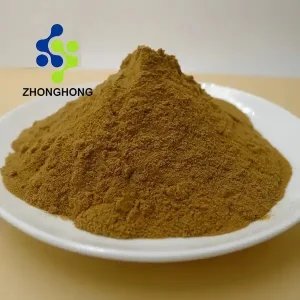Melatonin: Nature’s Sleep Regulator | Science-Backed Guide & Premium Ingredients
1. What is Melatonin?
Melatonin (CAS No. 73-31-4) is an endogenous indoleamine hormone primarily synthesized and secreted by the pineal gland in the brain. Its production is intrinsically linked to the circadian rhythm, heavily influenced by light-dark cycles. Often termed the “hormone of darkness,” melatonin levels naturally rise in the evening, signaling to the body that it’s time to prepare for sleep, and decrease in the morning with light exposure. Beyond its pivotal role in regulating the sleep-wake cycle, melatonin acts as a potent antioxidant and exhibits immunomodulatory properties. Its molecular formula is C₁₃H₁₆N₂O₂, with a molecular weight of 232.28 g/mol and an EINECS number of 200-797-7.
2. Product Source & Chemical Properties
-
Source: While naturally produced in humans and animals, commercial melatonin is typically synthesized. High-purity synthetic melatonin is identical in molecular structure to the endogenous hormone.
-
Chemical Properties:
-
CAS No.: 73-31-4
-
Molecular Formula: C₁₃H₁₆N₂O₂
-
Molecular Weight: 232.28 g/mol
-
EINECS: 200-797-7
-
Appearance: White or slightly yellow crystalline powder.
-
Solubility: Sparingly soluble in water; soluble in ethanol, methanol, and DMSO; soluble in alkaline solutions.
-
Melting Point: Approximately 116-120 °C.
-
Stability: Sensitive to light, heat, and oxidizing agents. Requires storage in cool, dark conditions.
Melatonin Benefits
-
3. Choosing the Best Melatonin Supplement: Key Considerations
Selecting an optimal melatonin supplement requires scrutiny beyond basic labeling. Premium quality hinges on rigorous science and manufacturing excellence.
-
Core Ingredient: Highly purified synthetic Melatonin (≥99% purity).
-
Efficacy & Compliance:
-
Sleep Onset & Quality: Clinically shown to reduce sleep latency (time to fall asleep) and improve subjective sleep quality, particularly for jet lag, shift work disorder, and delayed sleep-wake phase disorder (DSWPD) when used appropriately.
-
Antioxidant Activity: Scavenges free radicals and upregulates endogenous antioxidant enzymes (like glutathione peroxidase and superoxide dismutase).
-
Immune Modulation: Plays a role in regulating immune responses, though clinical applications are still evolving.
-
Compliance: Adheres strictly to pharmacopoeial standards (USP, EP, CP) and relevant food safety/FSSC 22000 regulations for intended use (dietary supplement, pharmaceutical ingredient).
-
-
Origin & Manufacturing: Sourced and manufactured under strict cGMP (current Good Manufacturing Practices) conditions, ideally by facilities with pharmaceutical-grade capabilities. Traceability from raw material to finished product is essential.
-
Usage:
-
Typical Dosage: Varies significantly based on individual needs and purpose. Starting low (0.5mg – 1mg) 30-60 minutes before bedtime is often recommended. Dosage can be adjusted under guidance.
-
How Long Does it Last? Melatonin has a relatively short half-life (30-60 minutes), but its physiological effects promoting sleepiness can last several hours. Immediate-release formulations peak within 1 hour.
-
-
Target Audience:
-
Adults experiencing occasional sleeplessness, jet lag, or mild circadian rhythm disruptions.
-
Shift workers.
-
Individuals with DSWPD (under medical guidance).
-
Note: Not typically recommended for chronic insomnia without medical evaluation.
-
-
Crucial Precautions & Side Effects:
-
Start Low, Go Slow: Avoid high doses initially. More isn’t necessarily better and can increase side effect risk.
-
Timing is Critical: Take only when you can dedicate sufficient time (7-8 hours) to sleep to avoid next-day drowsiness.
-
Daytime Drowsiness: The most common side effect, especially with higher doses or incorrect timing.
-
Headaches/Dizziness: Less common, but possible.
-
Vivid Dreams/Nightmares: Reported by some users.
-
Potential Interactions: Can interact with blood thinners (warfarin), immunosuppressants, anticonvulsants, certain antidepressants (SSRIs, MAOIs), blood pressure medications, and caffeine. Consult your doctor before use, especially if taking medications or have health conditions.
-
Contraindications: Generally not recommended during pregnancy, breastfeeding, for individuals with autoimmune diseases, or severe liver/kidney impairment without medical supervision.
-
How Much Melatonin is Too Much? While no universally defined acute lethal dose, doses exceeding 10mg daily are generally considered high and increase the likelihood of significant side effects like next-day impairment, hormone disruption, and potential impacts on reproductive health. Long-term safety of high doses is not well established. Medical supervision is crucial for doses above 5-10mg.
-
Does Melatonin Work? Yes, for specific circadian rhythm-related sleep issues like jet lag, shift work disorder, and DSWPD, the evidence is robust. For general insomnia, evidence is more mixed; it may help with sleep onset but less so with sleep maintenance. Effectiveness depends heavily on correct dosage and timing.
-
-
Daily Intake: There is no established Recommended Dietary Allowance (RDA). Doses used in research and for supplementation typically range from 0.5mg to 5mg daily, taken shortly before bedtime. Lower doses are often equally or more effective than higher ones for sleep initiation.
4. Premium Melatonin Source: Shaanxi Zhonghong Investment Technology Co., Ltd.
As a leading innovator in bioactive compounds, Shaanxi Zhonghong Investment Technology Co., Ltd. brings 28 years of expertise to the production of high-purity melatonin ingredients. We operate as a fully integrated high-tech enterprise, encompassing R&D, collaborative innovation, advanced manufacturing, and global distribution, specializing in chemistry, materials, and life sciences.
-
Core Focus: Advanced extraction, isolation, and purification of potent plant-derived compounds and premium synthetic bioactive molecules like Melatonin.
-
Product Range: Supplies premium ingredients across diverse sectors:
-
Natural Plant Extracts
-
Cosmetic Actives
-
Nutraceutical & Pharmaceutical Intermediates
-
Natural Pigments
-
Dietary Supplements
-
Food & Beverage Additives
-
Natural Sweeteners
-
-
Competitive Advantages:
-
Scientific Excellence: Strategic partnerships with 5 elite universities foster cutting-edge research. Our portfolio boasts 20+ proprietary patents and access to a globally unique compound library.
-
Cutting-Edge Technology: Employing HPLC (High-Performance Liquid Chromatography), NMR (Nuclear Magnetic Resonance Spectroscopy), and other state-of-the-art analytical instrumentation. Our commitment to purity exceeds industry standards by 20%+, guaranteeing batch-to-batch consistency and exceptional quality.
-
Global Reach: An established international network serves clients across 80+ countries in Asia, Europe, and the Americas. We excel in delivering customized ingredient solutions tailored to the specific needs of multinational pharmaceutical corporations, research institutions, and premium supplement brands.
-
Melatonin Benefits & Health Impact
Beyond its primary role in synchronizing the sleep-wake cycle, research suggests melatonin offers broader health benefits:
-
Powerful Antioxidant: Neutralizes harmful free radicals and boosts the body’s own antioxidant defenses, potentially protecting cells from oxidative stress damage linked to aging and chronic diseases.
-
Immune System Support: Modulates immune cell function and inflammatory responses, though clinical applications require further study.
-
Potential Neuroprotection: Investigated for its role in protecting neuronal cells, with relevance to conditions like Alzheimer’s and Parkinson’s (research ongoing).
-
Jet Lag Management: Effectively reduces symptoms and accelerates adaptation to new time zones.
-
Shift Work Support: Helps regulate sleep patterns disrupted by non-traditional work hours.
Melatonin Use Guidelines
-
Dosage: Begin with the lowest effective dose (typically 0.5mg – 1mg). Increase gradually only if necessary, rarely exceeding 5mg without medical advice.
-
Timing: Take 30-60 minutes before desired bedtime. Consistency is key for circadian rhythm support.
-
Environment: Administer in a low-light setting and prepare for sleep immediately afterward.
-
Duration: Generally recommended for short-term use (a few weeks). Long-term use should be discussed with a healthcare provider.
Melatonin Precautions Recap
-
Consult a Doctor: Essential before starting, especially with underlying health conditions, pregnancy/breastfeeding, autoimmune diseases, or medication use (see interactions above).
-
Avoid High Doses: >10mg significantly increases side effect risks.
-
Timing: Critical to prevent next-day drowsiness.
-
Driving/Machinery: Do not operate within 5 hours of taking melatonin.
-
Children: Use only under strict pediatric supervision.
Melatonin Product Specifications (Typical Premium Grade)
Certificate of Analysis (COA) – Key Specifications:
| Category | Parameter | Specification Limit | Test Method |
|---|---|---|---|
| Identification | Melatonin | Conforms | HPLC, FT-IR |
| Assay | Melatonin Content | ≥ 99.0% | HPLC |
| Pesticides | Total Pesticides | ≤ 0.1 ppm | GC-MS/MS, LC-MS/MS |
| Specific Pesticides (e.g., Acephate, Chlorpyrifos) | Absent or ≤ 0.01 ppm | GC-MS/MS, LC-MS/MS | |
| Heavy Metals | Lead (Pb) | ≤ 1.0 ppm | ICP-MS |
| Cadmium (Cd) | ≤ 0.5 ppm | ICP-MS | |
| Arsenic (As) | ≤ 1.0 ppm | ICP-MS | |
| Mercury (Hg) | ≤ 0.1 ppm | ICP-MS / CVAAS | |
| Microbiology | Total Aerobic Microbial Count | ≤ 1000 CFU/g | USP <61>, EP 2.6.12 |
| Total Combined Yeasts & Molds | ≤ 100 CFU/g | USP <61>, EP 2.6.12 | |
| Escherichia coli | Absent in 1g | USP <62>, EP 2.6.13 | |
| Salmonella spp. | Absent in 10g | USP <62>, EP 2.6.13 | |
| Staphylococcus aureus | Absent in 1g | USP <62> | |
| Residual Solvents | Class 1 Solvents (e.g., Benzene) | Absent | GC-FID, GC-MS (USP <467>, ICH Q3C) |
| Class 2/3 Solvents | Meet ICH Q3C Limits | GC-FID, GC-MS | |
| Impurities | Related Substances (Total) | ≤ 0.5% | HPLC |
| Any Individual Impurity | ≤ 0.1% | HPLC | |
| Physical | Appearance | White/Crystalline Powder | Visual |
| Loss on Drying | ≤ 0.5% | USP <731> | |
| Residue on Ignition | ≤ 0.1% | USP <281> |
Note: Specifications may vary slightly based on final application (pharma, food, supplement) and customer requirements. Batch-specific COA provided.
Advanced Production Process
Our melatonin synthesis employs a multi-step, tightly controlled chemical process:
-
Precision Synthesis: Starting from high-purity precursors, reactions occur under controlled conditions (temperature, pressure, pH).
-
Multi-Stage Purification: Utilizes techniques like crystallization, chromatography (preparative HPLC), and filtration to isolate the target molecule and remove impurities and residual solvents.
-
Lyophilization (Optional): For enhanced stability, the final product may undergo freeze-drying.
-
Stringent In-Process Controls (IPC): Rigorous checks at every critical step ensure process consistency and intermediate quality.
-
Final Purification & Drying: Achieves the target crystalline form and moisture content.
Melatonin Application Scenarios
-
Dietary Supplements: Sleep support capsules, tablets, gummies, liquids.
-
Pharmaceuticals: Prescription sleep aids, treatments for circadian rhythm disorders.
-
Functional Foods & Beverages: Sleep-enhancing drinks, bars, or fortified products (requires careful formulation for stability).
-
Cosmetic Applications: Investigated in topical formulations for antioxidant and potential skin-protective benefits.
Rigorous Quality Control (QC)
Shaanxi Zhonghong implements a comprehensive, multi-tiered QC system aligned with cGMP and ISO 9001 principles. This encompasses:
-
Qualified Supplier Program: Rigorous auditing and testing of all raw materials.
-
Validated Methods: All analytical procedures (HPLC, GC-MS, ICP-MS, microbiology) are fully validated per ICH Q2(R1) guidelines to ensure accuracy, precision, specificity, linearity, range, and robustness.
-
Stability Studies: Ongoing real-time and accelerated stability programs (ICH Q1A) determine shelf life and storage conditions.
-
Strict Environmental Monitoring: Controlled manufacturing environments with regular particulate and microbial air monitoring.
-
Traceability & Documentation: Complete batch records provide full traceability from raw material receipt to finished product release. Electronic data systems ensure integrity and compliance (21 CFR Part 11 if applicable).
-
Independent Verification: Third-party testing is utilized for critical parameters or customer verification.
Packaging & Global Logistics
-
Primary Packaging: High-grade materials ensure stability: double polyethylene bags inside food-grade HDPE drums or aluminum foil bags under inert gas (nitrogen) flush. Tamper-evident seals are standard.
-
Secondary Packaging: Robust cartons designed for transport.
-
Storage: -18°C (Long term), 2-8°C (Short term), or controlled room temperature (CRT 15-25°C) as per stability data, protected from light and moisture.
-
Global Logistics: Expertise in international shipping (DAP, FOB, CIF, etc.), handling customs clearance, and ensuring cold chain integrity where required. Comprehensive documentation (CoA, MSDS, Certificate of Origin, Commercial Invoice, Packing List) accompanies each shipment.
Health Efficacy, Research & Innovation
-
Mechanism: Primarily acts by agonizing MT1 and MT2 receptors in the suprachiasmatic nucleus (SCN – the brain’s “master clock”) and peripheral tissues, modulating circadian signals and promoting sleepiness. Its potent free radical scavenging activity occurs independently of receptor binding.
-
Clinical Evidence: Strongest for circadian rhythm disorders (jet lag, shift work, DSWPD). Evidence for primary insomnia is more variable. Antioxidant/neuroprotective effects are promising but require larger human trials.
-
Industry Innovation: Focus includes novel sustained-release formulations for prolonged effect, combination products (e.g., with magnesium, L-theanine), sublingual delivery for faster onset, and exploring therapeutic roles beyond sleep (e.g., migraine prevention, GI health).
-
Research Frontiers: Investigating melatonin’s role in metabolism (diabetes), oncology (adjuvant therapy), neuroprotection (Alzheimer’s, Parkinson’s), and COVID-19 (cytokine storm modulation) are active areas. Challenges include optimizing dosing regimens, understanding long-term effects of supplementation, improving bioavailability, and translating promising preclinical findings into robust clinical applications.
Melatonin FAQ
-
Q: How much melatonin should I take?
-
A: Start low! 0.5mg – 1mg taken 30-60 mins before bed is often sufficient. Increase gradually only if needed, rarely exceeding 5mg. Consult your doctor for personalized advice.
-
-
Q: How long does melatonin last in my system?
-
A: Its half-life is short (30-60 mins), but the sleep-promoting effects typically last 4-8 hours. Immediate-release peaks within 1 hour.
-
-
Q: Is 10mg of melatonin too much?
-
A: Yes, 10mg is generally considered a high dose. It significantly increases the risk of side effects like next-day grogginess, headaches, and potential hormonal disruption. Doses above 5-10mg require strict medical supervision. Less is often more effective.
-
-
Q: Does melatonin actually work?
-
A: Yes, it is clinically proven effective for managing jet lag, shift work sleep disorder, and delayed sleep-wake phase disorder. Its effectiveness for general insomnia is more variable but can help with falling asleep. Correct dosage and timing are crucial.
-
-
Q: Are there long-term risks?
-
A: Long-term safety data is limited. While generally considered safe for short-term use, potential impacts on reproductive hormones or immune function with chronic high-dose use are concerns needing more research. Medical guidance is recommended for prolonged use.
-
-
Q: Can I become dependent?
-
A: Melatonin is not addictive like traditional sleep medications. However, psychological dependence can occur if users feel they cannot sleep without it. Tapering off is usually straightforward.
-
-
Q: Where can I buy high-quality Melatonin ingredients?
-
A: Contact Shaanxi Zhonghong Investment Technology Co., Ltd. for premium Melatonin API and raw material.
-
Source Premium Melatonin & Custom Solutions
Shaanxi Zhonghong Investment Technology Co., Ltd. is your trusted partner for high-purity Melatonin API and ingredients. We specialize in custom synthesis, OEM, and ODM services, including formulating popular Melatonin Gummies.
-
Request a Free Sample: Experience our quality firsthand.
-
Discuss Bulk Supply or Custom Projects: Our technical team is ready to support your formulation needs.
-
Contact: liaodaohai@gmail.com
-
Learn More: aiherba.com
Conclusion
Melatonin is a vital, naturally occurring hormone essential for regulating sleep and circadian rhythms. When sourced from a reputable, science-driven manufacturer like Shaanxi Zhonghong Investment Technology Co., Ltd., high-purity melatonin offers a valuable tool for managing specific sleep disruptions and provides potent antioxidant benefits. Adherence to low, effective doses and proper timing is paramount for safety and efficacy. As research evolves, melatonin’s potential applications in health and wellness continue to expand, underpinned by rigorous science and advanced manufacturing capabilities.
References
-
Zisapel, N. (2018). New perspectives on the role of melatonin in human sleep, circadian rhythms and their regulation. British Journal of Pharmacology, 175(16), 3190-3199.
-
Auld, F., Maschauer, E. L., Morrison, I., Skene, D. J., & Riha, R. L. (2017). Evidence for the efficacy of melatonin in the treatment of primary adult sleep disorders. Sleep Medicine Reviews, 34, 10-22.
-
Costello, R. B., Lentino, C. V., Boyd, C. C., O’Connell, M. L., Crawford, C. C., Sprengel, M. L., & Deuster, P. A. (2014). The effectiveness of melatonin for promoting healthy sleep: a rapid evidence assessment of the literature. Nutrition Journal, 13, 106.
-
European Food Safety Authority (EFSA) NDA Panel. (2010). Scientific Opinion on the substantiation of health claims related to melatonin and alleviation of subjective feelings of jet lag (ID 1953), and reduction of sleep onset latency, and improvement of sleep quality (ID 1953) pursuant to Article 13(1) of Regulation (EC) No 1924/2006. EFSA Journal, 8(2), 1467.
-
European Pharmacopoeia (Ph. Eur.) Monograph for Melatonin.
-
U.S. Pharmacopeia (USP) Monograph for Melatonin.
-
Reiter, R. J., Rosales-Corral, S., Tan, D. X., Jou, M. J., Galano, A., & Xu, B. (2017). Melatonin as a mitochondria-targeted antioxidant: one of evolution’s best ideas. Cellular and Molecular Life Sciences, 74(21), 3863-3881.
-
National Institutes of Health (NIH) Office of Dietary Supplements – Melatonin Fact Sheet for Health Professionals. (Accessed July 2024).







评价
There are no reviews yet.